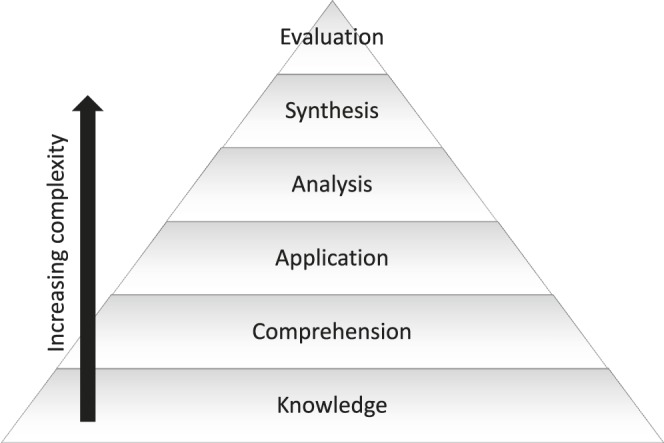Abstract
Information professionals who train or instruct others can use Bloom’s taxonomy to write learning objectives that describe the skills and abilities that they desire their learners to master and demonstrate. Bloom’s taxonomy differentiates between cognitive skill levels and calls attention to learning objectives that require higher levels of cognitive skills and, therefore, lead to deeper learning and transfer of knowledge and skills to a greater variety of tasks and contexts.
Keywords: Cognition, Classification, Teaching, Bloom’s TaxonomyLearning Objectives
As learners, we know from experience that some learning tasks are more difficult than others. To take an example from elementary school, knowing our multiplication tables by rote requires a qualitatively different type of thinking than does applying our multiplication skills through solving “word problems.” And in both cases, a teacher could assess our knowledge and skills in either of these types of thinking by asking us to demonstrate those skills in action, in other words, by doing something that is observable and measurable. With the publication in 1956 of the Taxonomy of Educational Objectives: The Classification of Educational Goals, an educational classic was born that powerfully incorporated these concepts to create a classification of cognitive skills [1]. The classification system came to be called Bloom’s taxonomy, after Benjamin Bloom, one of the editors of the volume, and has had significant and lasting influence on the teaching and learning process at all levels of education to the present day.
Bloom’s taxonomy contains six categories of cognitive skills ranging from lower-order skills that require less cognitive processing to higher-order skills that require deeper learning and a greater degree of cognitive processing (Figure 1). The differentiation into categories of higher-order and lower-order skills arose later; Bloom himself did not use these terms.
Figure 1.

Bloom’s taxonomy
Knowledge is the foundational cognitive skill and refers to the retention of specific, discrete pieces of information like facts and definitions or methodology, such as the sequence of events in a step-by-step process. Knowledge can be assessed by straightforward means, for example, multiple choice or short-answer questions that require the retrieval or recognition of information, for example, “Name five sources of drug information.” Health professionals must have command of vast amounts of knowledge such as protocols, interactions, and medical terminology that are committed to memory, but simple recall of facts does not provide evidence of comprehension, which is the next higher level in Bloom’s taxonomy.
Learners show comprehension of the meaning of the information that they encounter by paraphrasing it in their own words, classifying items in groups, comparing and contrasting items with other similar entities, or explaining a principle to others. For example, librarians might probe a learner’s understanding of information sources by asking the learner to compare and contrast the information found in those sources. Comprehension requires more cognitive processing than simply remembering information, and learning objectives that address comprehension will help learners begin to incorporate knowledge into their existing cognitive schemas by which they understand the world [2]. This allows learners to use knowledge, skills, or techniques in new situations through application, the third level of Bloom’s taxonomy. An example of application familiar to medical librarians is the ability to use best practices in the literature searching process, such as using Medical Subject Headings (MeSH) terms for key concepts in a search.
Moving to higher levels of the taxonomy, we next see learning objectives relating to analysis. Here is where the skills that we commonly think of as critical thinking enter. Distinguishing between fact and opinion and identifying the claims upon which an argument is built require analysis, as does breaking down an information need into its component parts in order to identify the most appropriate search terms.
Following analysis is the level of synthesis, which entails creating a novel product in a specific situation. An example of an evidence-based medicine–related task requiring synthesis is formulating a well-built clinical question after analyzing a clinician’s information gaps [3]. The formulation of a management plan for a specific patient is another clinical task involving synthesis.
Finally, the pinnacle of Bloom’s taxonomy is evaluation, which is also important to critical thinking. When instructors reflect on a teaching session and use learner feedback and assessment results to judge the value of the session, they engage in evaluation. Critically appraising the validity of a clinical study and judging the relevance of its results for application to a specific patient also require evaluative skills. It is important to recognize that higher-level skills in the taxonomy incorporate many lower-level skills as well: to critically appraise the medical literature (evaluation), one must have knowledge and comprehension of various study designs, apply that knowledge to a specific published study to recognize the study design that has been used, and then analyze it to isolate the various components of internal validity such as blinding and randomization. For an illustrative list of learning objectives from evidence-based medicine curricula at US and Canadian medical schools categorized according to Bloom’s taxonomy, refer to the 2014 Journal of the Medical Library Association article by Blanco et al. [3].
CHANGES IN BLOOM’S TAXONOMY
Based on findings of cognitive science following the original publication, a later revision of the taxonomy changes the nomenclature and order of the cognitive processes in the original version. In this later version, the levels are remember, understand, apply, analyze, evaluate, and create. This reorganization places the skill of synthesis rather than evaluation at the highest level of the hierarchy [2]. Furthermore, this revision adds a new dimension across all six cognitive processes. It specifies the four types of knowledge that might be addressed by a learning activity: factual (terminology and discrete facts); conceptual (categories, theories, principles, and models); procedural (knowledge of a technique, process, or methodology); and metacognitive (including self-assessment ability and knowledge of various learning skills and techniques).
COMMENTS
It is important to note that the most common usage of Bloom’s taxonomy focuses on cognitive learning skills rather than psychomotor or affective skills, two domains that are crucial to the success of health professionals. Examples of psychomotor and affective skills are knot tying in surgery and empathy toward patients, respectively.
Information professionals who train or instruct others can use Bloom’s taxonomy to write learning objectives that describe the skills and abilities that they desire their learners to master and demonstrate.
The taxonomy is useful in two important ways. First, use of the taxonomy encourages instructors to think of learning objectives in behavioral terms to consider what the learner can do as a result of the instruction. A learning objective written using action verbs will indicate the best method of assessing the skills and knowledge taught. Lists of action verbs that are appropriate for learning objectives at each level of Bloom’s taxonomy are widely available on the Internet [4]. Second, considering learning goals in light of Bloom’s taxonomy highlights the need for including learning objectives that require higher levels of cognitive skills that lead to deeper learning and transfer of knowledge and skills to a greater variety of tasks and contexts.
Today’s health professions educators wish to develop learners’ skills at the higher levels of Bloom’s taxonomy that require demonstration of deeper cognitive processing such as critical thinking and evaluative judgments, but studies have shown that learning objectives in many training programs and curricula focus overwhelmingly on the lower levels of the taxonomy, knowledge and comprehension [3, 5]. This shortcoming must be considered by educators if health professionals are to achieve increasing levels of skill and function.
Biography
Nancy E. Adams, MLIS,
nadams@hmc.psu.edu, Associate Director and Coordinator of Education and Instruction, George T. Harrell Health Sciences Library, Penn State Hershey Milton S. Hershey Medical Center, 500 University Drive, Mail Code H127, Hershey, PA 17033-0850
REFERENCES
- 1.Bloom BS. Taxonomy of educational objectives: the classification of educational goals. New YorkNY: Longmans, Green; 1956. [Google Scholar]
- 2.Anderson LW, Krathwohl DR. A taxonomy for learning, teaching, and assessing: a revision of Bloom’s taxonomy of educational objectives. New YorkNY: Longmans; 2001. [Google Scholar]
- 3.Blanco MA, Capello CF, Dorsch JL, Perry GJ, Zanetti ML. A survey study of evidence-based medicine training in US and Canadian medical schools. J Med Lib Assoc. 2014 Jul;102(3):160–8. doi: 10.3163/1536-5050.102.3.005. DOI: http://dx.doi.org/10.3163/1536-5050.102.3.005. [DOI] [PMC free article] [PubMed] [Google Scholar]
- 4.Office for Institutional Assessment, Clemson University . The University [cited 25 Jan 2015] Clemson, SC: Bloom’s taxonomy action verbs [Internet] < http://www.clemson.edu/assessment/assessmentpractices/referencematerials/>. [Google Scholar]
- 5.Légaré F, Freitas A, Thompson-Leduc P, Borduas F, Luconi F, Boucher A, Witteman HO, Jacques A. The majority of accredited continuing professional development activities do not target clinical behavior change. Acad Med. 2015 Feb;90(2):197–202. doi: 10.1097/ACM.0000000000000543. DOI: http://dx.doi.org/10.1097/ACM.0000000000000543. [DOI] [PubMed] [Google Scholar]


